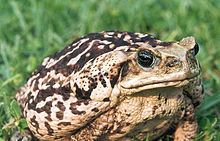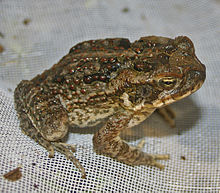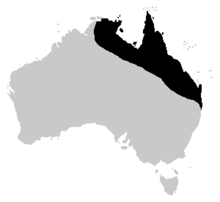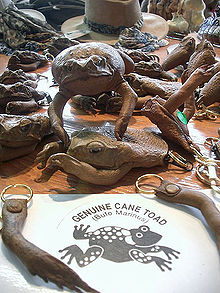
Cane toad
Background Information
SOS believes education gives a better chance in life to children in the developing world too. All children available for child sponsorship from SOS Children are looked after in a family home by the charity. Read more...
| Cane toad | |
|---|---|
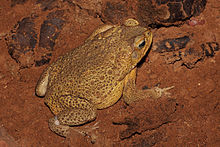 |
|
| Adult male | |
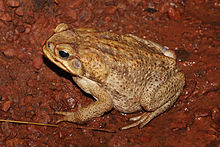 |
|
| Adult female | |
| Conservation status | |
 Least Concern ( IUCN 3.1) |
|
| Scientific classification | |
| Kingdom: | Animalia |
| Phylum: | Chordata |
| Class: | Amphibia |
| Order: | Anura |
| Family: | Bufonidae |
| Genus: | Rhinella |
| Species: | marinus |
| Binomial name | |
| Rhinella marinus (Linnaeus, 1758) |
|
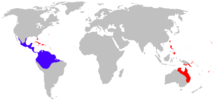 |
|
| Distribution of the cane toad. Native distribution in blue, introduced in red. | |
| Synonyms | |
|
Rhinella marina |
|
The cane toad (Bufo marinus), also known as the giant neotropical toad or marine toad, is a large, terrestrial true toad which is native to Central and South America, but has been introduced to various islands throughout Oceania and the Caribbean. It is a member of the subgenus Rhinella of the genus Bufo, which includes many different true toad species found throughout Central and South America. The cane toad is a prolific breeder; females lay single-clump spawns with thousands of eggs. Its reproductive success is partly because of opportunistic feeding: it has a diet, unusual among anurans, of both dead and living matter. Adults average 10–15 cm (3.9–5.9 in) in length; the largest recorded specimen weighed 2.65 kg (5.8 lb) with a length of 38 cm (15 in) from snout to vent.
The cane toad is an old species. A fossil toad (specimen UCMP 41159) from the La Venta fauna of the late Miocene of Colombia is indistinguishable from modern cane toads from northern South America. It was discovered in a floodplain deposit, which suggests the B. marinus habitat preferences have always been for open areas.
The cane toad has poison glands, and the tadpoles are highly toxic to most animals if ingested. Because of its voracious appetite, the cane toad has been introduced to many regions of the Pacific and the Caribbean islands as a method of agricultural pest control. The species derives its common name from its use against the cane beetle (Dermolepida albohirtum). The cane toad is now considered a pest and an invasive species in many of its introduced regions; of particular concern is its toxic skin, which kills many animals—native predators and otherwise—when ingested.
Taxonomy
Originally, cane toads were used to eradicate pests from sugar cane, giving rise to their common name. The cane toad has many other common names, including "giant toad" and "marine toad"; the former refers to its size and the latter to the binomial name, Bufo marinus. It was one of many species described by Linnaeus in his 18th-century work Systema Naturae (1735). Linnaeus based the specific epithet marinus on an illustration by Dutch zoologist Albertus Seba, who mistakenly believed the cane toad to inhabit both terrestrial and marine environments. Other common names include "giant neotropical toad", "Dominican toad", "giant marine toad", and "South American Cane Toad". In Trinidadian English, they are commonly called crapaud, the French word for toad.
The subgenus Rhinella is increasingly considered to constitute a distinct genus of its own, thus changing the scientific name of the cane toad. In this case the specific name marinus changes to marina in order to conform with the rules of gender agreement as set out by the International Code of Zoological Nomenclature changing the binomial name from Bufo marinus to Rhinella marina; the binomial Rhinella marinus was subsequently introduced as a synonym through misspelling by Pramuk, Robertson, Sites, and Noonan (2008). Though controversial (with many traditional herpetologists still using Bufo marinus) the binomial Rhinella marina is gaining in acceptance with such bodies as the IUCN, Encyclopaedia of Life, Amphibian Species of the World and increasing numbers of scientific publications adopting its usage.
In Australia, the adults may be confused with large native frogs from the genera Limnodynastes, Cyclorana and Mixophyes. These species can be distinguished from the cane toad by the absence of large parotoid glands behind their eyes and the lack of a ridge between the nostril and the eye. Cane toads have been confused with the giant burrowing frog (Heleioporus australiacus), because both are large and warty in appearance; however, the latter can be readily distinguished from the former by its vertical pupils and its silver-grey (as opposed to gold) iris. Juvenile cane toads may be confused with species of the Uperoleia genus, but their adult colleagues can be distinguished by the lack of bright colouring on the groin and thighs.
In the United States, the cane toad closely resembles many bufonid species. In particular, it could be confused with the southern toad (Bufo terrestris), which can be distinguished by the presence of two bulbs in front of the parotoid glands.
Description
The cane toad is very large; the females are significantly longer than males, reaching an average length of 10–15 cm (3.9–5.9 in). "Prinsen", a toad kept as a pet in Sweden, is listed by the Guinness Book of Records as the largest recorded specimen. It reportedly weighed 2.65 kg (5.84 lb) and measured 38 cm (15 in) from snout to vent, or 54 cm (21 in) when fully extended. Larger toads tend to be found in areas of lower population density. They have a life expectancy of 10 to 15 years in the wild, and can live considerably longer in captivity, with one specimen reportedly surviving for 35 years.
The skin of the cane toad is dry and warty. It has distinct ridges above the eyes, which run down the snout. Individual cane toads can be grey, yellowish, red-brown or olive-brown, with varying patterns. A large parotoid gland lies behind each eye. The ventral surface is cream-coloured and may have blotches in shades of black or brown. The pupils are horizontal and the irises golden. The toes have a fleshy webbing at their base, and the fingers are free of webbing.
The juvenile cane toad is much smaller than the adult cane toad at 5–10 cm (2.0–3.9 in) long. Typically, they have smooth, dark skin, although some specimens have a red wash. Juveniles lack the adults' large parotoid glands, so they are usually less poisonous. The tadpoles are small and uniformly black, and are bottom-dwellers, tending to form schools. Tadpoles range from 10 to 25 mm (0.39 to 0.98 in) in length.
Ecology, behaviour and life history
The common name "marine toad" and the scientific name Bufo marinus suggest a link to marine life, but the adult cane toad is entirely terrestrial, only venturing to fresh water to breed. Tadpoles have been found to tolerate salt concentrations equivalent to at most 15% that of seawater. The cane toad inhabits open grassland and woodland, and has displayed a "distinct preference" for areas that have been modified by humans, such as gardens and drainage ditches. In their native habitats, the toads can be found in subtropical forests, although dense foliage tends to limit their dispersal.
The cane toad begins life as an egg, which is laid as part of long strings of jelly in water. A female lays 8,000–25,000 eggs at once and the strings can stretch up to 20 metres (66 ft) in length. The black eggs are covered by a membrane and their diameter is approximately 1.7–2.0 mm (0.067–0.079 in). The rate at which an egg evolves into a tadpole is dependent on the temperature; the pace of development increases with temperature. Tadpoles typically hatch within 48 hours, but the period can vary from 14 hours up to almost a week. This process usually involves thousands of tadpoles—which are small, black and have short tails—forming into groups. It takes between 12 and 60 days for the tadpoles to develop into toadlets, with four weeks being typical. Similarly to their adult counterparts, eggs and tadpoles are toxic to many animals.
When they emerge, toadlets typically are about 10–11 mm (0.39–0.43 in) in length, and grow rapidly. While the rate of growth varies by region, time of year and gender, Zug and Zug found an average initial growth rate of 0.647 mm (0.0255 in) per day, followed by an average rate of 0.373 mm (0.0147 in) per day. Growth typically slows once the toads reach sexual maturity. This rapid growth is important for their survival; in the period between metamorphosis and subadulthood, the young toads lose the toxicity that protected them as eggs and tadpoles, but have yet to fully develop the parotoid glands that produce bufotoxin. Because they lack this key defence, only 0.5% of cane toads are estimated to reach adulthood.
As with rates of growth, the point at which the toads become sexually mature varies across different regions. In New Guinea, sexual maturity is reached by female toads with a snout–vent length between 70 and 80 mm (2.8 and 3.1 in), while toads in Panama achieve maturity when they are between 90 and 100 mm (3.5 and 3.9 in) in length. In tropical regions, such as their native habitats, breeding occurs throughout the year, but in subtropical areas, breeding occurs only during warmer periods that coincide with the onset of the wet season.
The cane toad is estimated to have a critical thermal maximum of 40–42 °C (104–108 °F) and a minimum of around 10–15 °C (50–59 °F). The ranges can change due to adaptation to the local environment. The cane toad has a high tolerance to water loss—one study showed some can withstand a 52.6% loss of body water, allowing them to survive outside tropical environments.
Diet
Most frogs identify prey by movement, and vision appears to be the primary method by which the cane toad detects prey; however, the cane toad can also locate food using its sense of smell. They eat a wide range of material; in addition to the normal prey of small rodents, reptiles, other amphibians, birds and a range of invertebrates, they also eat plants, dog food and household refuse. Cane toads have a habit of swallowing their prey.
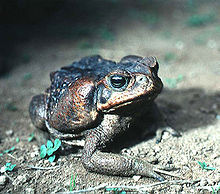
Defences
The skin of the adult cane toad is toxic, as well as the enlarged parotoid glands behind the eyes, and other glands across their backs. When the toads are threatened, their glands secrete a milky-white fluid known as bufotoxin. Components of bufotoxin are toxic to many animals; there have even been human deaths due to the consumption of cane toads.
Bufotenin, one of the chemicals excreted by the cane toad, is classified as a class 1 drug under Australian law, alongside heroin and cannabis. The effects of bufotenin are thought to be similar to those of mild poisoning; the stimulation, which includes mild hallucinations, lasts for less than an hour. As the cane toad excretes bufotenin in small amounts, and other toxins in relatively large quantities, toad licking could result in serious illness or death.
In addition to releasing toxin, the cane toad is capable of inflating its lungs, puffing up and lifting its body off the ground to appear taller and larger to a potential predator.
Poisonous sausages containing toad meat are being trialled in the Kimberley (Western Australia) to try to protect native animals from cane toads' deadly impact. The Western Australian Department of Environment and Conservation has been working with the University of Sydney to develop baits to train native animals not to eat the toads. By blending bits of toad with a nausea-inducing chemical, the baits train the animals to stay away from the amphibians. Researcher David Pearson says trials run in laboratories and in remote parts of the Kimberley region of WA are looking promising, although the baits will not solve the cane toad problem altogether.
Predators
Many species prey on the cane toad in its native habitat, including the broad-snouted caiman (Caiman latirostris), the banded cat-eyed snake (Leptodeira annulata), the eel (family: Anguillidae), various species of killifish, the rock flagtail ( Kuhlia rupestris), some species of catfish (order: Siluriformes). some species of ibis (subfamily: Threskiornithinae). and Paraponera clavata (bullet ants). Predators outside the cane toad's native range include the whistling kite (Haliastur sphenurus), the rakali (Hydromys chrysogaster), the black rat (Rattus rattus) and the water monitor (Varanus salvator). There have been occasional reports of the tawny frogmouth (Podargus strigoides) and the Papuan frogmouth (Podargus papuensis) feeding on cane toads; some Australian crow species (Corvus spp.) have also learned strategies allowing them to feed upon cane toads. Opossums of the Didelphis genus likely can eat cane toads with impunity.
Distribution
The cane toad is native to the Americas, and its range stretches from the Rio Grande Valley in South Texas to the central Amazon and southeastern Peru. This area encompasses both tropical and semiarid environments. The density of the cane toad is significantly lower within its native distribution than in places where it has been introduced. In South America, the density was recorded to be 20 adults per 100 m (109 yd) of shoreline, 1 to 2% of the density in Australia.
Introductions
The cane toad has been introduced to many regions of the world—particularly the Pacific—for the biological control of agricultural pests. These introductions have generally been well documented, and the cane toad may be one of the most studied of any introduced species.
Before the early 1840s, the cane toad had been introduced into Martinique and Barbados, from French Guiana and Guyana. An introduction to Jamaica was made in 1844 in an attempt to reduce the rat population. Despite its failure to control the rodents, the cane toad was introduced to Puerto Rico in the early 20th century in the hope that it would counter a beetle infestation ravaging the sugarcane plantations. The Puerto Rican scheme was successful and halted the economic damage caused by the beetles, prompting scientists in the 1930s to promote it as an ideal solution to agricultural pests.
As a result, many countries in the Pacific region emulated the lead of Puerto Rico and introduced the toad in the 1930s. There are introduced populations in Australia, Florida, Papua New Guinea, the Philippines, the Ogasawara, Ishigaki Island and the Daitō Islands of Japan, most Caribbean islands, Fiji and many other Pacific islands, including Hawaii. Since then, the cane toad has become a pest in many host countries, and poses a serious threat to native animals.
Australia
Following the apparent success of the cane toad in eating the beetles threatening the sugarcane plantations of Puerto Rico, and the fruitful introductions into Hawaii and the Philippines, there was a strong push for the cane toad to be released in Australia to negate the pests that were ravaging the Queensland cane fields. As a result, 102 toads were collected from Hawaii and brought to Australia. After an initial release in August 1935, the Commonwealth Department of Health decided to ban future introductions until a study was conducted into the feeding habits of the toad. The study was completed in 1936 and the ban lifted, at which point large-scale releases were undertaken; by March, 1937, 62,000 toadlets had been released into the wild. The toads became firmly established in Queensland, increasing exponentially in number and extending their range into the Northern Territory and New South Wales. Recently, the toads have made their way into Western Australia and one has even been found on the far western coast in Broome.
However, the toad was generally unsuccessful in reducing the targeted beetles, in part because the cane fields provided insufficient shelter for the predators during the day. Since its original introduction, the cane toad has had a particularly marked effect on Australian biodiversity. The population of a number of native predatory reptiles has declined, such as the varanid lizards Varanus mertensi, V. mitchelli, and V. panoptes, the land snakes Pseudechis australis and Acanthophis antarcticus, and the crocodile species Crocodylus johnstoni; in contrast, the population of the agamid lizard Amphibolurus gilberti—known to be a prey item of V. panoptes—has increased.
Caribbean
The cane toad was introduced to various Caribbean islands to counter a number of pests infesting local crops. While it was able to establish itself on some islands, such as Barbados, Jamaica, and Puerto Rico, other introductions, such as in Cuba before 1900 and in 1946, and on the islands of Dominica and Grand Cayman, were unsuccessful.
The earliest recorded introductions were to Barbados and Martinique. The Barbados introductions were focused on the biological control of pests damaging the sugarcane crops, and while the toads became abundant, they have not been as successful in controlling the pests as in Australia. The toad was introduced to Martinique from French Guiana before 1944 and became established. Today, they reduce the mosquito and mole cricket populations. A third introduction to the region occurred in 1884, when toads appeared in Jamaica, reportedly imported from Barbados to help control the rodent population. While they had no significant effect on the rats, they nevertheless became well established. Other introductions include the release on Antigua—possibly before 1916, although there are suggestions that this initial population may have died out by 1934 and been reintroduced at a later date— and Montserrat, which saw an introduction before 1879 that led to the establishment of a solid population, which was apparently sufficient to survive the Soufrière Hills volcano eruption in 1995.
In 1920, the cane toad was introduced into Puerto Rico to control the populations of white-grub (Phyllophaga spp.), a sugarcane pest. Before this, the pests were manually collected by humans, so the introduction of the toad eliminated labor costs. A second group of toads was imported in 1923, and by 1932, the cane toad was well established. The population of white-grubs dramatically decreased, and this was attributed to the cane toad at the annual meeting of the International Sugar Cane Technologists in Puerto Rico. However, there may have been other factors. The six-year period after 1931—when the cane toad was most prolific, and the white-grub saw dramatic decline—saw the highest-ever rainfall for Puerto Rico. Nevertheless, the cane toad was assumed to have controlled the white-grub; this view was reinforced by a Nature article titled "Toads save sugar crop", and this led to large-scale introductions throughout many parts of the Pacific.
More recently, the cane toad has been spotted in Carriacou and Dominica, the latter appearance occurring in spite of the failure of the earlier introductions.
The Philippines
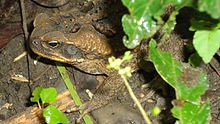
The cane toad was first introduced deliberately into the Philippines in 1930 as a biological control agent of pests in sugarcane plantations. This was done after the 'success' of the experimental introductions into Puerto Rico. It subsequently became the most ubiquitous amphibian in the islands. It still retains the common name of kamprag in the Visayan languages, a corruption of 'American frog', referring to its origins. It is also commonly known as 'bullfrog' in Philippine English.
Fiji
The cane toad was introduced into Fiji to combat insects that infested sugarcane plantations. The introduction of the cane toad to the region was first suggested in 1933, following the successes in Puerto Rico and Hawaii. After considering the possible side effects, the national government of Fiji decided to release the toad in 1953, and 67 specimens were subsequently imported from Hawaii. Once the toads were established, a 1963 study concluded, as the toad's diet included both harmful and beneficial invertebrates, it was considered "economically neutral". Today, the cane toad can be found on all major islands in Fiji, although they tend to be smaller than their counterparts in other regions.
New Guinea
The cane toad was successfully introduced into New Guinea to control the hawk moth larvae eating sweet potato crops. The first release occurred in 1937 using toads imported from Hawaii, with a second release the same year using specimens from the Australian mainland. Evidence suggests a third release in 1938, consisting of toads being used for human pregnancy tests—many species of toad were found to be effective for this task, and were employed for about 20 years after the discovery was announced in 1948. Initial reports argued the toads were effective in reducing the levels of cutworms and sweet potato yields were thought to be improving. As a result, these first releases were followed by further distributions across much of the region, although their effectiveness on other crops, such as cabbages, has been questioned; when the toads were released at Wau, the cabbages provided insufficient shelter and the toads rapidly left the immediate area for the superior shelter offered by the forest. A similar situation had previously arisen in the Australian cane fields, but this experience was either unknown or ignored in New Guinea. The cane toad has since become abundant in rural and urban areas.
United States
The cane toad naturally exists in South Texas, but attempts (both deliberate and accidental) have been made to introduce the species to other parts of the country. These include introductions to Florida and to the islands of Hawaii, as well as largely unsuccessful introductions to Louisiana.
Initial releases into Florida failed. Attempted introductions before 1936 and 1944, made with the objective of controlling sugarcane pests, were unsuccessful as the toads failed to proliferate. Later attempts failed in the same way. However, the toad gained a foothold in the state after an accidental release by an importer at Miami International Airport in 1957, and deliberate releases by animal dealers in 1963 and 1964 established the toad in other parts of Florida. Today, the cane toad is well established in the state, from the Keys to north of Tampa, and they are gradually extending further northward. In Florida, the toad is a regarded as a threat to both native species and to pets, so much so, the Florida Fish and Wildlife Conservation Commission recommends residents euthanize them.
Around 150 cane toads were introduced to Oahu in Hawaii in 1932, and the population swelled to 105,517 after 17 months. The toads were sent to the other islands, and more than 100,000 toads were distributed by July 1934; eventually over 600,000 were transported.
Uses
Other than the previously mentioned use as a biological control for pests, the cane toad has been employed in a number of commercial and noncommercial applications. Traditionally, within the toad's natural range in South America, the Embera-Wounaan would "milk" the toads for their toxin, which was then employed as an arrow poison. The toxins may have been used as an entheogen by the Olmec people. The toad has been hunted as a food source in parts of Peru, and eaten after the removal of the skin and parotoid glands. More recently, the toad's toxins have been used in a number of new ways: bufotenin has been used in Japan as an aphrodisiac and a hair restorer, and in cardiac surgery in China to lower the heart rates of patients.
Other modern applications of the cane toad include pregnancy testing, as pets, laboratory research, and the production of leather goods. Pregnancy testing was conducted in the mid-20th century by injecting urine from a woman into a male toad's lymph sacs, and if spermatozoa appeared in the toad's urine, the patient was deemed to be pregnant. The tests using toads were faster than those employing mammals; the toads were easier to raise, and, although the initial 1948 discovery employed Bufo arenarum for the tests, it soon became clear that a variety of anuran species were suitable, including the cane toad. As a result, toads were employed in this task for around 20 years. As a laboratory animal, the cane toad is regarded as ideal; they are plentiful, and easy and inexpensive to maintain and handle. The use of the cane toad in experiments started in 1950s, and by the end of 1960s, large numbers were being collected and exported to high schools and universities. Since then, a number of Australian states have introduced or tightened importation regulations. Even dead toads have value. Cane toad skin has been made into leather and novelty items; stuffed cane toads, posed and accessorised, have found a home in the tourist market, and attempts have been made to produce fertilizer from their bodies.
